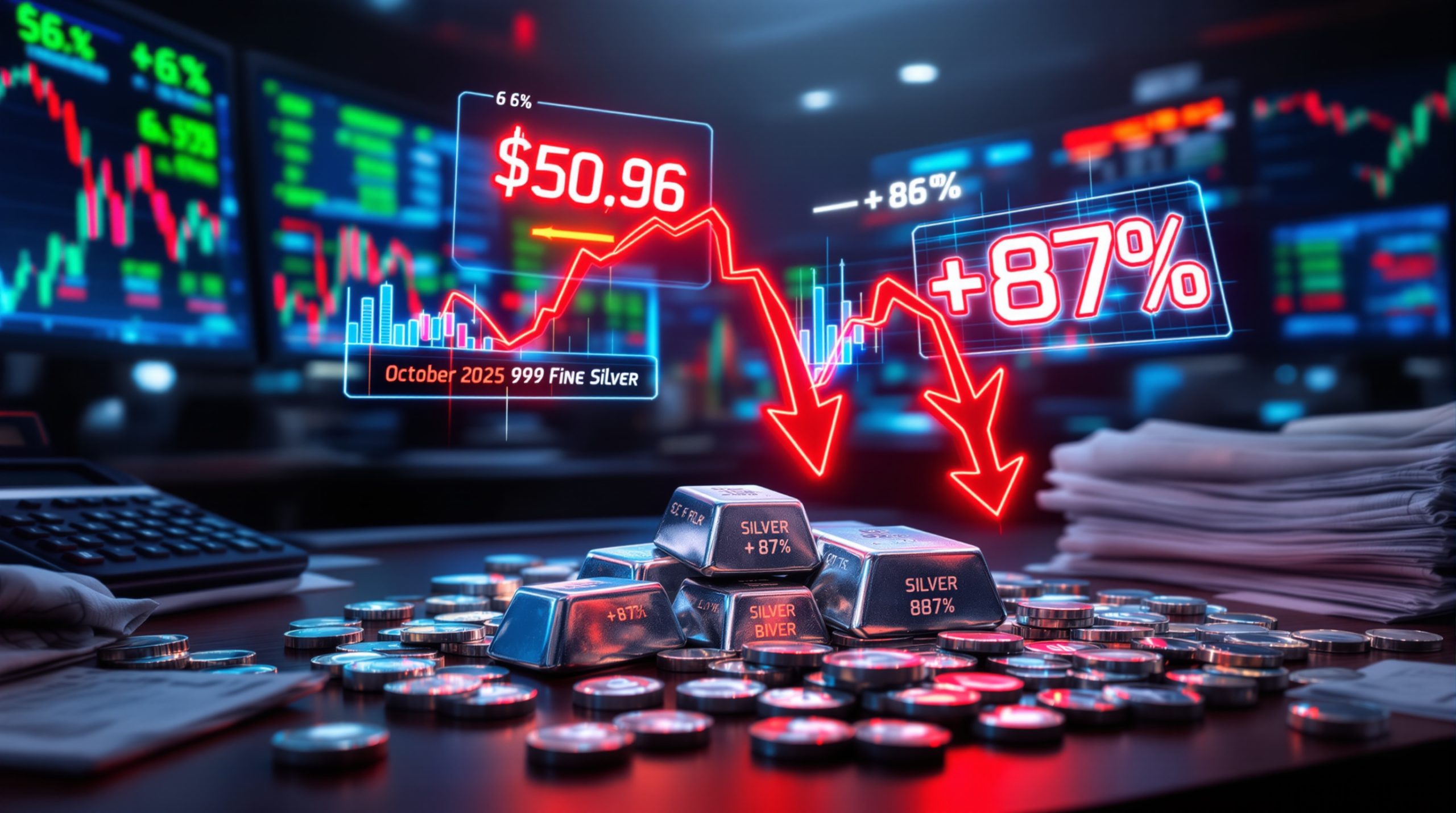What Are the Latest Trends in US Inflation Data?
The inflation landscape in the United States has been showing consistent signs of cooling, with four consecutive months of downside surprises in both Consumer Price Index (CPI) and Producer Price Index (PPI) reports. Core Personal Consumption Expenditures (PCE), the Federal Reserve's preferred inflation metric, continues its downward trajectory, signaling a potential shift in economic conditions.
Real-time inflation tracking from blockchain-based services like Truflation, which monitors approximately 30 million prices daily without seasonal adjustments, indicates inflation rates of approximately 1.9%, which falls below the Federal Reserve's 2% target. This real-time inflation data in the US often provides earlier signals than official statistics.
Recent Inflation Surprises
The gap between input cost increases and companies' ability to pass these costs to consumers has widened significantly. This pricing power constraint represents a fundamental shift in the inflation dynamic, as businesses increasingly absorb cost increases rather than passing them to end consumers.
"What we're witnessing is a classic disconnect between pricing power and purchasing power. Companies simply cannot maintain their desired margins as consumer spending capacity deteriorates." – Danielle DiMartino Booth
Official inflation data continues to show moderation, with core readings declining more consistently than headline figures. This trend suggests that underlying inflationary pressures are easing across multiple sectors, not just in volatile categories like energy and food.
The Pricing Power vs. Purchasing Power Dynamic
A critical factor in the inflation story is the deterioration of aggregate income growth as unemployment claims rise. With nearly two million continuing jobless claimants reported in recent data, consumer purchasing power faces increasing constraints.
The labor market presents a more complex picture than headline unemployment rates suggest. Increasing numbers of gig workers, part-time employees, and self-employed individuals mask true employment weakness. This "hidden unemployment" further erodes aggregate purchasing power in ways not fully captured by traditional metrics.
- Rising unemployment claims despite reported "full employment"
- Wage growth reversing for job-changers compared to job-stayers
- Declining real income when adjusted for inflation
- Increased reliance on credit to maintain spending levels
Housing and Rental Inflation Lag
One of the most significant factors potentially distorting inflation readings is the methodology used to calculate housing costs in official CPI data. Housing components, which constitute roughly one-third of the CPI basket, operate with considerable lag times.
Census Bureau data reveals that 50% of new apartments remain unrented three months after construction, a clear indication of softening demand that isn't yet reflected in official inflation statistics. The true rental market softness is unlikely to appear in official statistics until late 2025 into 2026, creating a persistent overstatement of inflation.
This lag effect creates a situation where:
- Real-time rental markets show declining rates
- New lease data indicates significant concessions and incentives
- Official CPI housing component continues showing increases
- Full incorporation of market reality delays for 12-18 months
Experts point to this housing measurement lag as a critical factor that may be causing the Federal Reserve to maintain restrictive policy longer than necessary, as they rely on official statistics that overstate current inflation conditions.
How Is the US Consumer Economy Performing?
Consumer stress signals are multiplying across various economic indicators, suggesting that household financial resilience is deteriorating despite seemingly strong headline economic figures. A closer examination reveals concerning trends that may foreshadow broader economic challenges.
Signs of Consumer Stress
Major banks have been steadily increasing loss provisions for their credit card portfolios, with Citibank recently announcing higher provisions for anticipated future loan losses. This proactive preparation for credit deterioration suggests financial institutions are seeing early warning signs in consumer payment behaviors.
Continuing jobless claims have reached their highest levels since the pandemic, approaching the critical 260,000 threshold that has historically signaled recession risk. This trend reflects not just temporary layoffs but a more persistent inability of displaced workers to find new employment.
Wage growth patterns have shifted significantly, with job-changers now seeing smaller gains than job-stayers—a complete reversal from patterns observed during the post-pandemic recovery. This wage growth inversion typically occurs when labor market conditions soften and employer bargaining power increases.
Diminishing Sources of Consumer Spending Power
Historical patterns of consumer spending support are systematically ending, creating a potential "perfect storm" for consumer spending capacity:
| Decade | Primary Consumer Spending Support | Current Status |
|---|---|---|
| 2000s | Home equity extraction | Limited by higher rates |
| 2010s | Student loan borrowing | Repayments now enforced |
| 2020s | Pandemic stimulus and loose credit | Ended and tightening |
Current legislation lacks the stimulus measures seen in previous economic challenges, with new policies potentially creating income shocks through reinstated student loan payment requirements. The removal of mortgage modification provisions that previously supported homeowners during hardship periods further reduces financial flexibility.
"We've systematically removed every safety net that supported consumer spending over the past two decades, yet we expect consumption to remain resilient. That's simply not realistic economic math." – Danielle DiMartino Booth
Credit Cycle Deterioration
Bankruptcy filings have reached their highest levels since 2010, with both consumer and business filings showing concerning acceleration. This trend typically lags other economic indicators, suggesting the financial stress has been building for some time before manifesting in formal bankruptcy proceedings.
Credit standards are tightening across all lending categories, with:
- Higher minimum credit score requirements
- Increased documentation demands
- Reduced loan-to-value ratios
- Higher debt-to-income thresholds
- Elimination of certain loan products entirely
Small businesses face particularly difficult financing conditions, with loan approval rates dropping to levels that threaten business formation and expansion. This credit constraint affects not just struggling businesses but even those with strong fundamentals, limiting overall economic dynamism.
Household credit access is becoming more restricted just as savings buffers accumulated during the pandemic have largely been depleted. This combination of factors creates increased vulnerability to income shocks or unexpected expenses.
What Are the Federal Reserve's Next Likely Moves?
The Federal Reserve finds itself at a critical policy juncture, with increasing evidence suggesting they may be maintaining restrictive monetary policy longer than economic conditions warrant. This potential policy error carries significant implications for markets and the broader economy.
Policy Error Concerns
Initial jobless claims are approaching the critical threshold of 260,000, a level that has historically coincided with recession conditions. This unemployment indicator, combined with inflation metrics consistently coming in below expectations, creates a compelling case for monetary policy adjustment.
The growing disconnect between economic data and Fed policy stance has raised concerns about the Federal Reserve's responsiveness to changing conditions. While the Fed has emphasized its data dependency, markets increasingly question whether the central bank is appropriately weighing deteriorating economic signals.
"There's mounting evidence that the Fed is fighting yesterday's inflation battle while ignoring today's economic reality. Powell risks becoming the emperor with no clothes as data continues to deteriorate." – Danielle DiMartino Booth
The impact of restrictive policy is not uniform across the economy. Small businesses and households face disproportionate pressure from elevated interest rates, while larger corporations with access to capital markets can more easily navigate the high-rate environment.
Market Expectations vs. Fed Guidance
Markets are increasingly pricing in rate cuts despite the Fed's "higher for longer" rhetoric, creating a notable divergence between policymaker communication and investor expectations. This gap reflects growing skepticism about the Fed's assessment of economic conditions.
| Time Horizon | Market-Implied Rate Cut Probability | Fed Dot Plot Indication |
|---|---|---|
| September 2025 | 78% | No cut projected |
| December 2025 | 95% | Possible single cut |
| March 2026 | 99% | Gradual reduction path |
This divergence creates potential volatility risks, as markets may need to rapidly reprice assets if either the Fed pivots suddenly or economic conditions deteriorate faster than anticipated. The monetary policy narrative is being tested as economic indicators increasingly point to weakness rather than resilience.
Timing of Potential Rate Cuts
Growing evidence suggests the Federal Reserve may already be behind the curve in adjusting policy. Core PCE is expected to continue declining based on recent PPI data, with leading indicators suggesting further disinflation ahead.
Economic uncertainty is increasing pressure for monetary policy adjustment, with deflationary concerns potentially emerging in certain sectors. The historical pattern of Fed policy suggests central bankers typically wait too long to pivot, then must act more aggressively to counter deteriorating conditions.
The timeline for potential rate cuts appears to be accelerating, with market participants increasingly expecting action before year-end rather than in 2026 as previously anticipated. This compressed timeline reflects the speed at which economic conditions are changing.
Why Are Precious Metals Gaining Investor Attention?
Precious metals have moved to the forefront of investor attention as economic uncertainty increases and traditional market correlations shift. This renewed interest reflects both tactical positioning and strategic portfolio considerations.
Silver's Recent Performance
Silver prices have touched the $37 mark after a period of underperformance, playing catch-up to gold after lagging behind for several quarters. This breakout from previous trading ranges signals significant momentum building in the silver market.
The gold-stock relationship has compressed from historically elevated levels, suggesting silver's recent outperformance may continue. Typically, silver exhibits higher volatility than gold, amplifying both upside and downside moves.
Industrial demand for silver remains robust despite economic uncertainty, providing fundamental support beyond investment demand. This dual-purpose nature—both monetary metal and industrial input—creates a unique value proposition compared to other precious metals.
Historical Patterns During Economic Uncertainty
Precious metals have traditionally outperformed during deflationary scares, contrary to the common perception that they are purely inflation hedges. Investors seek safe havens when Fed policy appears misaligned with economic conditions, precisely the situation many market participants perceive today.
"Metals serve as portfolio shock absorbers during periods when traditional correlations break down. They're not just inflation hedges—they're uncertainty hedges." – Danielle DiMartino Booth
Platinum prices have also shown breakout patterns, indicating the precious metals rally extends beyond just gold and silver. This broad-based strength across the metals complex suggests systematic capital flows rather than metal-specific speculation.
Historical analysis reveals precious metals typically perform best during periods of:
- Economic inflection points
- Monetary policy uncertainty
- Credit cycle deterioration
- Rising risk premiums
- Liquidity concerns
Role in Investment Portfolios
Precious metals function as stability mechanisms during economic inflection points, providing hedges against uncertainty when economic indicators are mixed. This portfolio role becomes particularly valuable during credit cycle deterioration and rising bankruptcies.
The current economic environment—featuring mixed signals between employment, inflation, and growth—creates precisely the type of uncertainty that historically benefits precious metals allocations. Rather than attempting to time perfect entry points, experienced investors often maintain strategic allocations regardless of short-term price movements.
Metals serve as assets outside the financial system, offering protection against systemic risks that can impact traditional financial assets simultaneously. This non-correlation becomes increasingly valuable when financial system stress increases.
A strategic allocation of 5-10% to precious metals has historically improved risk-adjusted returns during periods of economic transition, according to portfolio studies. This diversification benefit extends beyond simple return enhancement to include volatility reduction during market stress.
How Are Global Trade Tensions Affecting Economic Outlook?
Global trade tensions have reemerged as a significant factor influencing economic projections and market sentiment. The complex interplay between tariff policies, supply chains, and consumer behavior creates both immediate effects and longer-term structural adjustments.
US-China Trade Relationship
Historical precedent demonstrates that comprehensive trade deals require significant time to negotiate, with the 2018-2019 US-China negotiations illustrating the complexity of reaching meaningful agreements. Those talks extended over 18 months despite substantial economic pressure.
Weak economic data emerging from China potentially influences negotiating positions, creating additional complexity in the current environment. Chinese manufacturing PMI has remained in contraction territory for several consecutive months, limiting policy flexibility.
Import surges are occurring ahead of potential tariffs impact markets, creating temporary distortions in trade data. This pre-tariff buying typically creates inventory buildups that later contribute to import declines once tariffs are implemented, amplifying economic volatility.
European Economic Pressures
The German service sector is experiencing substantial pressure, with recent PMI readings below 48.2, firmly in contraction territory. As Europe's largest economy, Germany's performance serves as a bellwether for broader European economic conditions.
Pre-tariff buying is potentially masking true economic conditions in Europe, as businesses accelerate purchases ahead of potential trade restrictions. This temporary surge in activity often reverses sharply once tariffs are implemented, creating a whipsaw effect in economic data.
The pendulum will likely swing toward import declines as purchasing power diminishes, particularly as credit conditions tighten globally. This pattern follows historical examples where initial inventory building is followed by extended periods of destocking.
Counterintuitive Inflation Effects
US tariffs & inflation are initially perceived as inflationary but potentially become disinflationary over time as growth effects outweigh direct price impacts. The historical example from 2018-2019 demonstrates this counterintuitive result, with CPI declining from 2.4% to 1.8% during tariff implementation.
"The conventional wisdom that tariffs are automatically inflationary misses the second-order effects. Growth drag typically outweighs the direct price effects, ultimately creating disinflationary pressure." – Danielle DiMartino Booth
This counterintuitive outcome occurs through several mechanisms:
- Initial price increases reduce purchasing power
- Reduced purchasing power constrains consumer spending
- Inventory buildups lead to eventual discounting
- Business uncertainty reduces capital investment
- Employment growth slows, further reducing demand
Congressional negotiations surrounding trade policy add to economic uncertainty, limiting business planning and investment. This uncertainty plateau maintains pressure on business decision-making even before policies are formally implemented.
What Should Investors Consider in the Current Environment?
The current economic landscape presents unique challenges that require thoughtful portfolio positioning and ongoing monitoring of key indicators. Investors should consider both defensive positioning and strategic opportunities created by market dislocations.
Portfolio Stability Strategies
Maintaining a precious metals allocation serves as an uncertainty hedge during periods of economic transition. The non-correlation benefits of metals become particularly valuable when traditional asset relationships become unstable.
Recognizing economic inflection points provides portfolio rebalancing opportunities, allowing investors to adjust allocations before consensus shifts occur. These transition periods often create temporary mispricing that disciplined investors can exploit.
Understanding the relationship between uncertainty levels and safe haven demand helps investors maintain perspective during market volatility. Historical patterns suggest that periods of policy uncertainty typically benefit defensive assets even before economic data confirms deterioration.
Economic Indicator Monitoring
Tracking continuing jobless claims provides a key economic health signal that often precedes broader market movements. The current level approaching 2 million claims warrants close attention as a potential warning sign.
Following real-time inflation metrics beyond official statistics provides earlier insights into changing price trends. Blockchain-based services like Truflation, which monitors 30 million prices daily, can identify inflation shifts before they appear in official CPI reports.
Observing credit conditions across consumer and business sectors helps identify stress points before they manifest in broader economic data. Current trends showing tightening standards across lending categories suggest growing caution from financial institutions.
Key indicators to monitor include:
- Initial and continuing jobless claims
- Credit card delinquency rates
- Commercial real estate vacancy trends
- Small business loan approval rates
- Bond market credit spreads
- Real-time price tracking indices
Long-Term Investment Perspective
Recognizing precious metals as portfolio stabilizers during uncertain periods helps investors maintain discipline rather than making emotional decisions. This stability function becomes particularly valuable when economic data sends mixed signals.
Understanding metals' historical performance during deflationary concerns challenges the conventional wisdom that they only perform well during inflation. This broader appreciation of metals' behavior across economic scenarios supports more nuanced allocation decisions.
"Metals aren't just for inflation protection—they're insurance against policy errors and unexpected economic developments. Their value derives from what they're not, rather than what they are." – Danielle DiMartino Booth
Viewing precious metals as insurance against policy errors helps justify maintaining allocations regardless of short-term price movements. Like other forms of insurance, their value becomes most apparent precisely when needed most—during periods of financial stress or economic disruption.
FAQ: Understanding US Inflation and Economic Indicators
How does the calculation method affect official inflation statistics?
Official inflation statistics like CPI use methodologies that create significant lag times, particularly in housing and rental components. These components can take 12-18 months to fully reflect market changes, potentially causing official statistics to overstate inflation when housing markets are softening, as seen in current conditions.
The rental component of CPI relies on survey data that inherently lags actual market conditions. When new lease rates are declining but existing leases remain unchanged, the official statistics capture a blended rate that understates the magnitude and timing of market shifts.
For example, Census Bureau data showing 50% of new apartments remaining unrented three months after construction indicates significant market softness that won't be fully reflected in CPI for over a year.
What signals indicate the Federal Reserve might be maintaining restrictive policy too long?
Key signals include four consecutive months of downside inflation surprises, rising continuing jobless claims approaching 260,000, declining aggregate income growth, increasing credit charge-offs by major banks, and real-time inflation tracking showing rates below the Fed's 2% target.
The divergence between leading indicators (showing weakness) and lagging indicators (showing resilience) creates policy risk. The Fed historically places greater weight on lagging indicators, potentially creating delayed responses to changing conditions.
The current configuration of economic data—disinflation alongside
Ready to Get Ahead of Major Mineral Discoveries?
Discovery Alert's proprietary Discovery IQ model scans ASX announcements in real-time, delivering instant notifications on significant mineral discoveries before the market reacts. Visit our discoveries page to see how early investors in historic finds secured exceptional returns, then start your 30-day free trial to position yourself for the next major opportunity.




